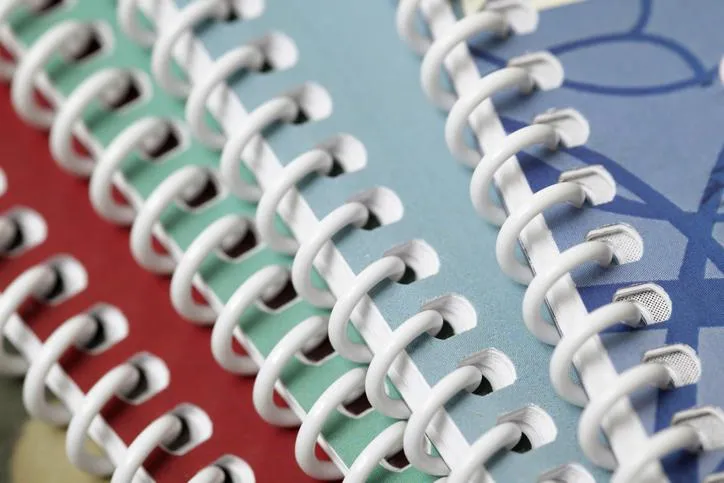
Binding Basics: 4 Print Finishes That Make Your Project Pop
🎵 If print had a theme song, it might just be "I Wanna Take It to the CMYK!" But catchy tunes aside, let's talk about something that doesn’t always get the spotlight - but should: Binding.
Binding might sound like the least exciting part of your print project, but it’s one of the most important. It determines how your piece feels in the hands, how it functions when opened, and how polished it looks on a desk or display. Whether you're printing a product catalog, booklet, journal, or training manual, the binding method you choose can enhance (or hinder) both form and function.
Let’s break down four common types of binding, their pros and cons, and when to use each.
1. Plastic Coil Binding (Spiral Binding)
This is the one you’ve probably seen on school notebooks or manuals. It uses a flexible plastic spiral that’s inserted through punched holes along the edge of the book.
Pros:
Lay-flat capability: No matter where you open it, it lies flat on a table - perfect for hands-free reading.
Flexible and durable: Great for workbooks or guides that will be flipped through often.
Cost-effective for short runs.
Cons:
A bit casual in appearance - not ideal for premium or presentation-grade materials.
Doesn’t stack or shelve neatly.
Great For:
Workbooks
Instruction manuals
Notebooks and guides
2. Wire Binding (Metal Coil)
This one’s a step up from plastic coil - same concept, but with a sturdier metal wire instead. Also sometimes called "wire-o" binding.
Pros:
Professional appearance compared to plastic coil.
Still lays flat, which makes it user-friendly.
Stronger and more durable for frequent handling.
Cons:
Slightly higher cost than plastic.
Can get bent if tossed around carelessly.
Best for:
Portfolios
Presentations that need a polished edge
💡 Tip: If you're looking to level up your print game from plastic coil to something more refined, this is a great middle ground.
3. Perfect Binding (Glued Edge)
Think of your favorite magazine or softcover book. That clean, squared spine? That’s called perfect binding. The pages are stacked, the edges are trimmed, and a strong glue holds them together.
Pros:
Sleek, polished look.
Easy to label the spine - ideal for shelf storage.
Feels like a “real book,” which lends credibility and weight to the content.
Cons:
Not lay-flat - if you try to open it wide, it may crack or not stay open on its own.
Works best with thicker documents (typically more than 40 pages).
Best for:
🧠 Smart tip: Perfect binding can elevate your brand perception - it’s the go-to for clients who want something that looks premium but remains cost-effective.
4. Saddle Stitching (Stapled Spine)
This method is exactly what it sounds like - two staples through the fold line of the booklet. It’s simple, fast, and gets the job done.
Pros:
Highly economical.
Great for shorter documents (usually under 64 pages).
Quick turnaround and easy production.
Cons:
Doesn’t lay flat well.
Not ideal for high-page counts or heavy-use items.
The spine can’t be labeled.
Best for:
Event programs
Newsletters
Bonus Binding Tip: Form Follows Function
The right binding method comes down to how your piece will be used.
Want it to lie flat on a desk? Go for coil or wire binding.
Need it to look high-end for a client or presentation? Perfect binding is your friend.
Tight budget and quick deadlines? Saddle Stitching gets the job done fast.
Why Binding Matters More Than You Think
Binding is the bridge between design and usability. It affects how your audience interacts with your content. It influences how your brand is perceived. And most importantly, it can either elevate your message, or undermine it.
Imagine handing someone a beautifully designed brochure that keeps snapping shut when they try to read it. Frustrating, right? That’s why binding shouldn’t be an afterthought.
Want Help Choosing the Right Binding?
There are dozens of binding options beyond these basics such as case binding, loop stitching, screw post, PUR binding… even custom hybrid options. So whether you’re putting together a short-run employee handbook or a high-impact product catalog, we’ll help you find the perfect finish.
Let’s chat about your next print project!
Our team can walk you through options, samples, pricing, and timelines to make sure your project not only looks great, but works the way you want it to.
Contact Us Today or Book a Meeting with one of our Industry Experts. We’re always happy to talk print!
